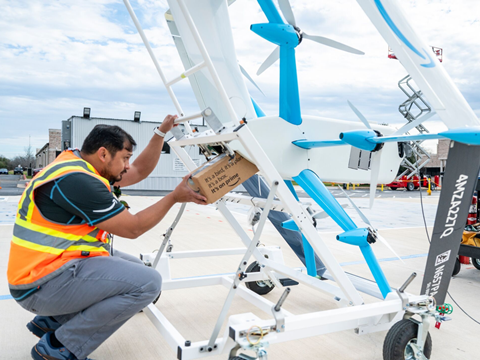
The UK’s Civil Aviation Authority (CAA) has permitted Amazon to fly drones beyond a human operator’s line of sight and trial small e-commerce deliveries via its Prime Air service. Amazon also plans to run a similar project in Italy this year.
In October 2023, Amazon stated its intentions to deliver packages by drone in Italy and the UK by late 2024. Now it is one of six organizations selected to experiment with flying drones in UK airspace beyond an operator’s line of sight.
Its drones will be permitted to fly to distances of around 12 kilometres from their base in one of the UK’s fulfilment centres. According to officials, the trials will examine how the drones identify and avoid other aircraft, as well as the signals sent to flag their presence to others in the airspace and air traffic control. Kirkwall Airport in the Orkney Islands has been named as one of the testing locations.
“Exploring the options of how drones can be safely and successfully incorporated into more of the UK’s airspace is key,” said Frederic Laugere, head of Innovation Advisory Services at the CAA. “It is vital that projects such as this take place to feed into the overall knowledge and experiences that will soon enable drones to be operating beyond the line of sight of their pilot on a day-to-day basis, while also still allowing safe and equitable use of the air by other users.”
Regarding a project in Italy, Pierluigi Di Palma, president of the Italian Civil Aviation Authority (ENAC), commented: “The future has arrived in Italy. Being chosen by a global player such as Amazon is further confirmation of the strategy pursued by ENAC to push for innovation of advanced air mobility in the aviation industry, creating a national ecosystem favourable to the safe development of new services. Italy’s experience will be an inspiration and support for safe operations in the rest of Europe.”
“For some time, the Italian Air Navigation Service Provider (ENAV) has looked beyond air traffic control, to the management of airspace as infrastructure available for the economic growth of the country,” added ENAV CEO Pasqualino Monti. “We support projects such as Amazon’s drone delivery, and we are aware of our role not only as a service provider but as a true strategic industrial partner.”
Amazon told The Independent last year that it would load small packages of up to five pounds in weight into the drone’s dedicated storage container at its fulfilment centres. The drones would then carry the delivery to a delivery point, usually a consumer’s garden, and eject it from the air.
Whereas most drones are not able to sense or avoid hazards and obstacles, Amazon has designed a ‘sophisticated’ and ‘industry-leading’ sense-and-avoid system – aiming to ensure safety when carrying the product in transit and when lowering towards the ground.
Amazon’s algorithms are said to utilize a ‘diverse suite’ of technologies to identify static objects in the drone’s path, as well as moving objects on the horizon, and change its course to avoid them. The drone is also said to steer clear or people, animals, and other obstacles when landing.
Consumers are not expected to pay extra for the service, which will be offered alongside the usual range of delivery options.
The Prime Air programme has already been launched in Lockeford, California, and College Station, Texas – claiming to deliver in less than an hour from click to delivery. Nevertheless, delays, regulations, and the loss of both executives and employees have slowed its rollout elsewhere.
Back in 2016, Amazon Air trialled the delivery of a TV streaming stick and bag of popcorn to a consumer in Cambridge – said to be a completely autonomous flight with no human pilot involved. At the time, packages needed to be below 2.6 kilograms in weight, and consumers were required to a) live nearby to a delivery depot, and b) have a large enough garden that ejecting a package form the air would not be a risk.
Yet Amazon’s drone operations were downscaled in the UK throughout 2020 and 2021, with Wired reporting that workers came to the end of short-term contracts or faced redundancies.
Other services have also been competing with Prime Air; in the United States, for example, Walmart has been working with Zipline’s drone service since 2020, and with Alphabet’s Wing since 2023.
All the way back in 2020, our editor Libby Munford spoke to Robert Garbett, founder and chief executive of independent drone advisory service The Drone Major Group, to learn more about the future trajectory of the drone industry. Our editor at large Elisabeth Skoda also noted that, in order for such delivery processes to be completely unmanned, packaging would need to be redesigned to resist theft and damage from the elements.
More recently, Amazon has been named as a recurring finalist in this year’s Sustainability Awards; once in the Machinery category for its automated packaging machines, and once alongside Mondi in the E-Commerce category for their paper-padded delivery envelope. The winners will be announced over dinner at the Sustainable Packaging Summit in Amsterdam (12th – 13th November 2024).
If you liked this story, you might also enjoy:
How are the top brands progressing on packaging sustainability?
Sustainable Innovation Report 2024: Current trends and future priorities
Reuse vs. single use – which is better for the environment?
The ultimate guide to global plastic sustainability regulation












No comments yet